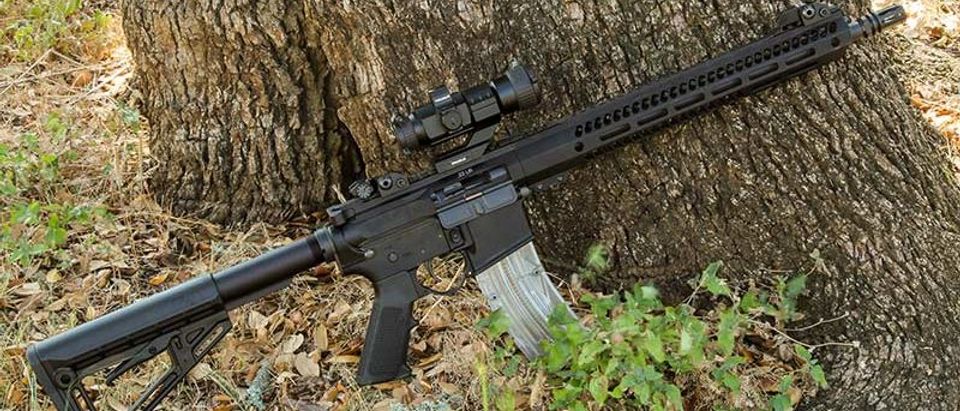By Mike Cumpston with Stan Jarosz, GUNS Magazine
Rimfire conversion units for the AR platform, as well as complete .22 long rifle arms, have been around about as long as the rifle itself. My experience with them is far from extensive, though in the mid-’80s I harvested two bullfrogs with a Colt conversion on top of a CAR 16 with the switch on full buzz. This is about the only way to smoke two B-frogs at basically the same time.
A decade or more ago, I shot the Colt rimfire “understudy” to the Stoner platform and, as seems to be the case with other AR 22s, selection of materials, design and construction are — in keeping with the significantly lower price — not on the same plane as the center-fire rifles. The reliability of previous .22s could be described as “Tedious and Occasional.” Rock River Arms changed this situation at SHOT 2019 with the introduction of a family of bone-serious complete rifles built of the same material and to the same standard as their well-respected center-fire line.
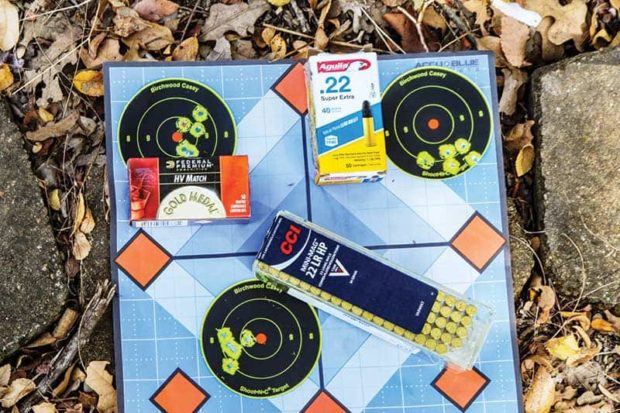
The 50-yard groups shot from the Caldwell Lead Sled averaged well under an inch.
Lineup
There are three variations. The basic MID A4 is a knock-off of the U.S. military-issue carbine with the familiar plastic handguard. The next model is an NM A4 CMP Trainer featuring a longer stainless match-chambered heavy barrel inside an M-Lock alloy rail. As the designation implies, it’s deemed an understudy for National Match and Civilian Marksmanship gear.
The Tactical Carbine was the first model out the door in late Summer 2019 and the one we have on hand for testing. The Tactical Carbine, like the NM/CMP, comes with an alloy hand guard configured for M-lock accessories. All three models are optics-ready with a Picatinny rail full length on the receiver and at the front of the hand guard.
The Tactical Carbine (like the MID A4) has a 16″ barrel and weighs 6 lbs., 4 oz. after we mounted a TRUGLO Ignite 30mm electronic dot sight over a set of auxiliary Irons from Ozark Armament. Common to all three models is the six-position collapsible stock, while the Tactical and CMP Trainer models have the catch enclosed inside of the skeletal structure to shield from inadvertent release. With the stock fully forward, the carbine is 32.5″ long and 37.25″ at full extend.
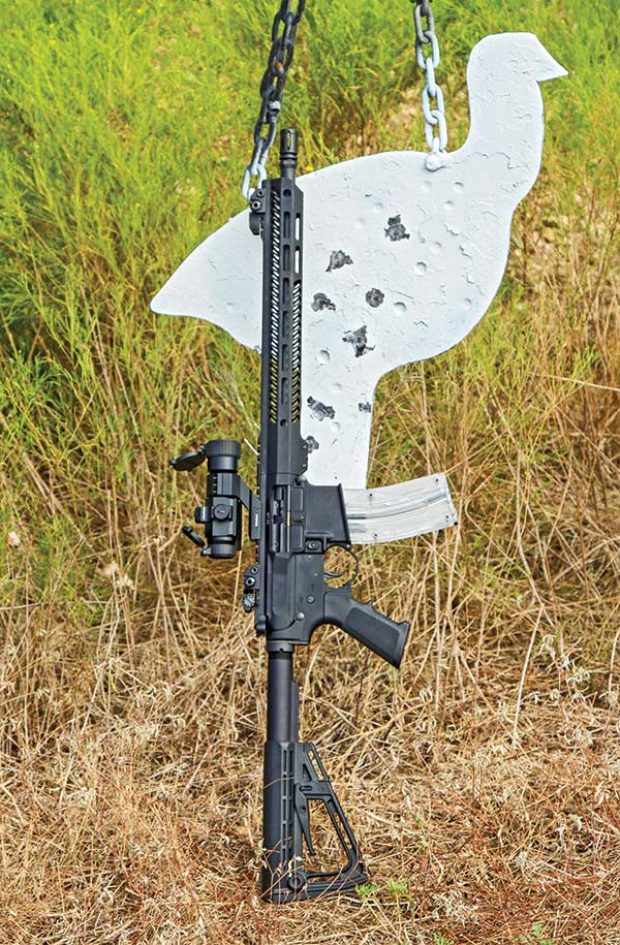
The muzzle-heavy carbine hangs steady on the 100-yard turkey. Mike found the turkey hard to miss with the LAR 22 and the 2-minute dot sight.
Spec It Up
The lower unit is basic to the RRA line — a forged aluminum lower marked “RRA LAR 15 M Multi Caliber.” There is also a polymer variation costing about $100 less. The upper is likewise forged aluminum with chrome moly 16″ barrel with 1:16 twist. The trigger is a mil-spec two-stage version with an ideal 5 1/2-lb. pull. The A2 Flash Hider on the suppressor-threaded barrel rounds out the features falling short of the Full Gorilla only in rifles lacking a bayonet lug and grenade launcher.
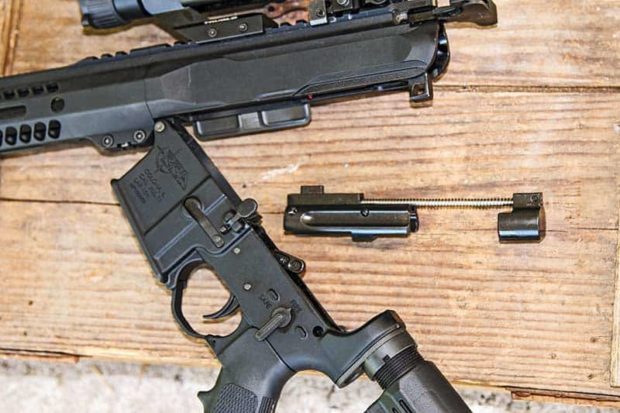
Routine disassembly is much the same as the centerfire AR15 however the recoil spring is part of the bolt with no need for a recoil buffer.
Manual Of Arms
A basic construction and dismounting drill, unlike many of the rimfires, is a close mirror of the larger rifles though a bolt-mounted recoil spring takes the place of the standard buffer tube arrangement. The buffer tube is functionally superfluous, giving rise to the notion the system might be an ideal basis for a handgun or even a quality knock-off of the C96 Mauser. The receiver has no forward assist. This is a good thing as applying force to chamber a rimfire round is not a good thing to do.
The bolt lock system also differs from the center-fire ARs. It locks all the way back with an empty magazine in place but there is no way to manually lock it back when the magazine is out. Removing the empty magazine drops the bolt and it’s necessary to work the charge handle to chamber a round. The manual bolt lock will lock the bolt back about 3/4″ and can be used to close the bolt from this position. This would be a handy way of inserting and retaining the chamber flag required on many ranges.
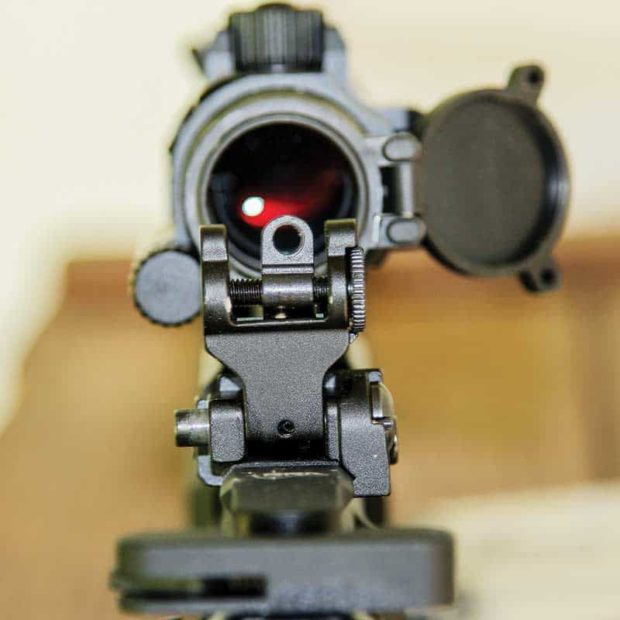
The back-up iron sights are in mil-spec profile and easy to use with or without the optical sight mounted.
The Full Package
The TRUGLO Ignite 30mm optic with a 2-minute dot and cantilever mount sits atop the flat receiver at the ideal height to allow co-witness with Ozark Armament Micro Flip Up back-up sights. The red dot sight runs on one AAA battery and toggles through 10 brightness levels. Suggested retail is a bit over $200 but Optics Planet and Amazon list it at well under $200.
Experience with more expensive electronic sights led me to install the battery and leave the unit in “off” mode for several days to see if the battery would die. It remained charged and the battery is still alive weeks later. The TRUGLO has a wide field of view and the multi-coated lenses are as clear as they should be.
I can’t really address the sharpness of the dot. Both Stan and I have astigmatism that will grow faux fuzz on the best reticle. Nevertheless, I had no trouble shooting groups significantly smaller than the inch a 2-minute dot covers at 50 yards. The back-up sights are a good idea with any primary optical system and the Ozark Armory aperture sights provided excellent rapid-fire accuracy at 50 yards.
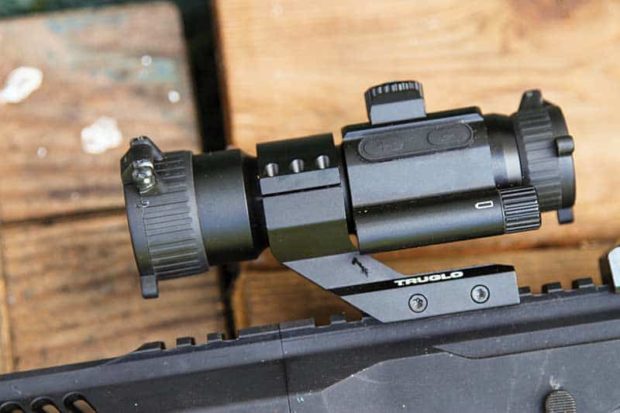
Loading Up
I had five varieties of .22 long rifle ammunition and the rifle was totally reliable throughout a considerable amount of shooting. Aguila Super Extra and CCI Standard Velocity at 1073 fps and 1038 fps were standard velocity loads with 10-round spreads of 37 and 23 fps. Federal HV Match at 1,193 fps showed an extreme spread of 38 fps. CCI Mini-Mag solid clocked 1,203/81 the 37-gr. Mini-Mag HP read 1,293/93 fps.
Paradoxically, the Mini Mag RN and HP had the widest extreme spreads over 10 rounds but, in keeping with my long-term experience with this round, together with the CCI Standard Velocity, had the best and most consistent 5-round, 50-yard groups over the Lead Sled. All three CCI loads produced back-to-back groups of .90 caliber and the hollow point shot the best group of the day at 0.73″.
The LAR .22 seems not to be a bit “ammo sensitive.” Worst group of the day measured 1.2″ with Aguila Super Extra standard velocity loads.
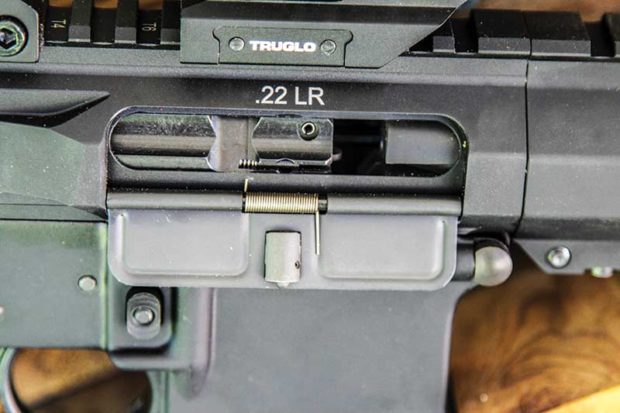
The Fun Part
Given the superior quality of the LAR carbine and its sterling performance it seems only proper to avoid the word “plink.” Instead we, backed off 100 yards and “engaged” some white painted hanging steel — a silhouette turkey and a 10″ round plate. Stan Jarosz shot a bench group on the round thing and then proceeded to shoot an off-hand cluster not much bigger. I concentrated on the steel guajolote, aiming at the top of its back to compensate for the 5″ to 6″ drop from a 50-yard zero, and proceeded to ding the thing regularly and at a brisk pace.
The 6.5-lb. rifle with the balance tilted toward the muzzle hangs very steady on target and the 5.5-lb. trigger is just about perfect for off-hand shooting. It seemed almost impossible to miss the 100-yard targets. We flipped up the Ozark back-up sights and shot the same targets off-hand from 50 yards. These sights clamp to the accessory rail, lying flat and out of the way until needed. They have the same small and large aperture as the basic M16 sight and adjust in the same manner. Acquisition of the sight picture through the intervening dot sight was unimpeded and it seemed to be impossible to miss even shooting at a frenetic, Dillon Thomas-like cadence.
Both Stan and I were very impressed with the Rock Island/LAR 22 and had a lot of fun ringing it out. It certainly put to rest my long-standing prejudices formed around the earlier rimfire AR Conversions. MSRP $630, polymer lower $550.
Thanks to GUNS Magazine for this post. Click here to visit GunsMagazine.com.
Click here to follow Guns Magazine on Facebook.
Click here to subscribe to GUNS Magazine and get it delivered to your door.


